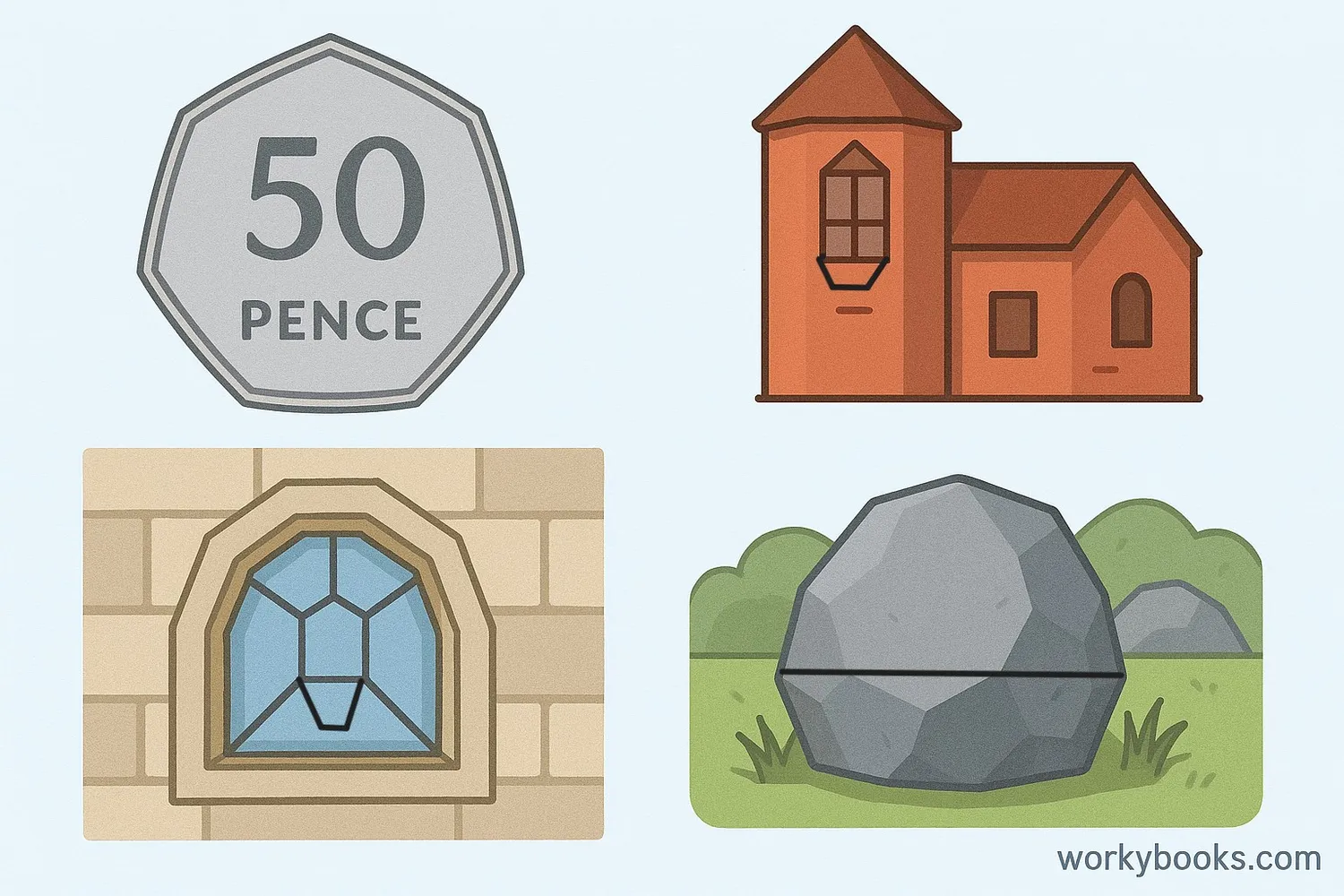Heptagon - Definition, Examples, Quiz, FAQ, Trivia
Learn about the seven-sided polygon with easy explanations, examples, and practice activities
What is a Heptagon?
A heptagon is a polygon with seven sides and seven angles. The word "heptagon" comes from the Greek words "hepta" meaning seven and "gonia" meaning angle.
Heptagons can be found in various real-world objects, like certain coins, architectural designs, and natural formations. They are interesting shapes because they have an odd number of sides, which gives them unique properties.
All heptagons have 7 sides, 7 vertices (corner points), and 7 angles. The sum of all interior angles in any heptagon is always 900 degrees.
Key Concept
A heptagon is a seven-sided polygon. "Hepta" means seven, and "gon" means angle or corner.
Heptagon Properties
Heptagons have specific geometric properties that make them unique:
| Property | Value/Description |
|---|---|
| Number of Sides | 7 |
| Number of Vertices | 7 |
| Number of Angles | 7 |
| Sum of Interior Angles | 900° |
| Sum of Exterior Angles | 360° |
| Number of Diagonals | 14 |
To calculate the sum of interior angles for any polygon, you can use the formula: (n-2) × 180°, where n is the number of sides. For a heptagon, this is (7-2) × 180° = 5 × 180° = 900°.
The number of diagonals in a polygon can be calculated using the formula: n(n-3)/2. For a heptagon, this is 7(7-3)/2 = 7×4/2 = 14 diagonals.
Remember
All heptagons have 7 sides, but they can look different depending on whether they're regular or irregular.
Regular vs Irregular Heptagons
Heptagons can be classified into two main types:
Regular Heptagon: All seven sides are equal in length, and all seven interior angles are equal (approximately 128.57° each). A regular heptagon also has rotational symmetry and reflection symmetry.
Irregular Heptagon: Sides are not equal in length, and angles are not equal. The interior angles still add up to 900°, but each angle can be different.
Interior Angle Formula (Regular Heptagon)
For a regular heptagon: (7-2) × 180° ÷ 7 = 5 × 180° ÷ 7 ≈ 128.57°
Regular heptagons are less common in everyday objects than irregular heptagons because their construction is more complex. However, they appear in some architectural designs and mathematical patterns.
Did You Know
Regular heptagons cannot be constructed with just a compass and straightedge, which makes them different from many other regular polygons.
Heptagon Area Formula
Calculating the area of a regular heptagon requires knowing either the side length or the apothem (the distance from the center to the midpoint of a side).
The formula for the area of a regular heptagon is:
Area Formula (Regular Heptagon)
or approximately: A ≈ 3.63391 × s²
Where s is the length of one side
If you know the apothem (a), the formula becomes:
Area Using Apothem
Where a is the apothem and s is the side length
For irregular heptagons, there is no single formula. You would need to divide the shape into smaller shapes (like triangles and rectangles), calculate each area, and then add them together.
Example
For a regular heptagon with side length 5 cm: Area ≈ 3.63391 × 5² = 3.63391 × 25 ≈ 90.85 cm²
Real-World Examples

Heptagons appear in various real-world contexts:
1. Coins: The British 50 pence coin and 20 pence coin are heptagonal (seven-sided). This shape makes them easily identifiable by touch.
2. Architecture: Some buildings feature heptagonal elements, such as towers, windows, or floor plans. The Tower of the Winds in Athens has an octagonal shape but influenced heptagonal designs.
3. Natural Formations: While less common than hexagons in nature, some crystals and geological formations exhibit heptagonal patterns.
4. Design and Art: Heptagons are used in various designs, including quilts, tiles, and logos, for their visually interesting properties.
Fun Fact
The British 50p coin is a heptagon but with curved sides, making it an equilateral curved heptagon that has a constant diameter.
Heptagon Practice Quiz
Test your knowledge about heptagons with this 5-question quiz. Choose the correct answer for each question.
Frequently Asked Questions
Here are answers to common questions about heptagons:
Geometry Trivia
Discover interesting facts about polygons and geometry:
Ancient Geometry
The ancient Greeks were fascinated by regular polygons and spent considerable time studying their properties. However, the heptagon posed particular challenges due to its construction difficulties.
Heptagon Angles
The interior angles of a regular heptagon are approximately 128.57° each. This number is exactly 900°/7, but since 900 isn't divisible by 7 evenly, we get a repeating decimal.
Currency Design
The British 20p and 50p coins are heptagonal (7-sided) with curved edges. This shape was chosen because it's easily distinguishable by touch from other coins and it rolls smoothly in vending machines.
Heptagons in Nature
While hexagons are common in nature (like honeycombs), heptagons are much rarer. Some flowers have seven petals, and certain crystals form heptagonal patterns, but perfect heptagons are unusual in the natural world.


